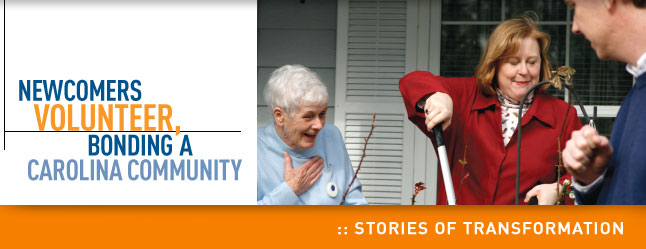
Newcomers Volunteer, Bonding a Carolina Community
Article from Knight Foundation 2006 Annual Report
“The more you’re involved in your community, the stronger the civic fabric becomes.”
That’s Knight Foundation’s Susan Patterson talking about a big experiment under way along South Carolina’s Grand Strand, where a potential gold mine of civic engagement exists in the sizable pool of retired professionals, seasonal visitors and second-home owners drawn by golf, sun and sand.
This cluster of visitors and retirees swells Horry County’s population from 250,000 to 1.4 million during the peak season. Local leaders of this once rural – and poor – South Carolina county believe that by more effectively tapping this reservoir of talent for the greater good, transformation can take place.
“Horry County is really several different worlds,” says Patterson, Knight’s program director for Myrtle Beach.
Connecting those worlds — natives, longtime residents, part-time snowbirds, retirees and service-oriented college students — is the long-term goal of a Knight-funded effort in Myrtle Beach called StepUp! just getting under way.
Says Patterson: “The place we thought we would start is volunteerism.”
“Do these folks with a lot of experience, expertise and creativity in their own way continue to participate, or do they just retire to the golf course?” asks Patterson. “Our thinking is that the more you’re involved in your community, the stronger the civic fabric becomes. Increasing engagement could and likely will transform the community.”
Knight funding helped Coastal Carolina University launch StepUp!, a coordinated effort to connect volunteers to organizations that provide services. “We, the people who live here 24/7, know how fantastic this community is and how many nonprofit agencies are out there making a difference,” says StepUp! director Valerie Harrington. “My favorite part of this job is connecting people to those agencies.”
StepUp! targets four categories of potential volunteers: young people 18 and under, newcomers, snowbirds and residents 50 and older. The program’s television and radio public service ads have generated a dramatic increase in calls from newcomers.
“Our earlier surveys indicated that it was taking five to seven years for newcomers to feel connected to community,” says Harrington.
“Now we’re hearing from newcomers who say ‘tell me more about how I can volunteer.'”
The area’s nonprofit organizations see the benefit to their work and mission. Christine Ellis of Waccamaw Riverkeeper headed a recent cleanup effort.
“Especially when a new person joins our team, they say, ‘I never realized there was so much trash.’ But there is so much potential for impact associated with our growth and urbanization,” says Ellis. “These efforts are good education and promotion for our mission.”
Art Allerie, a retired engineer from Ottawa, Ontario, has returned to Myrtle Beach each year since 1999 with his wife, Rejeanne. He began volunteering by serving meals to needy families at the holidays.
“You feel better that you did something for somebody,” he says. “Even if I’m not back home, I’m returning something to the local community. It makes me feel good.” For further information